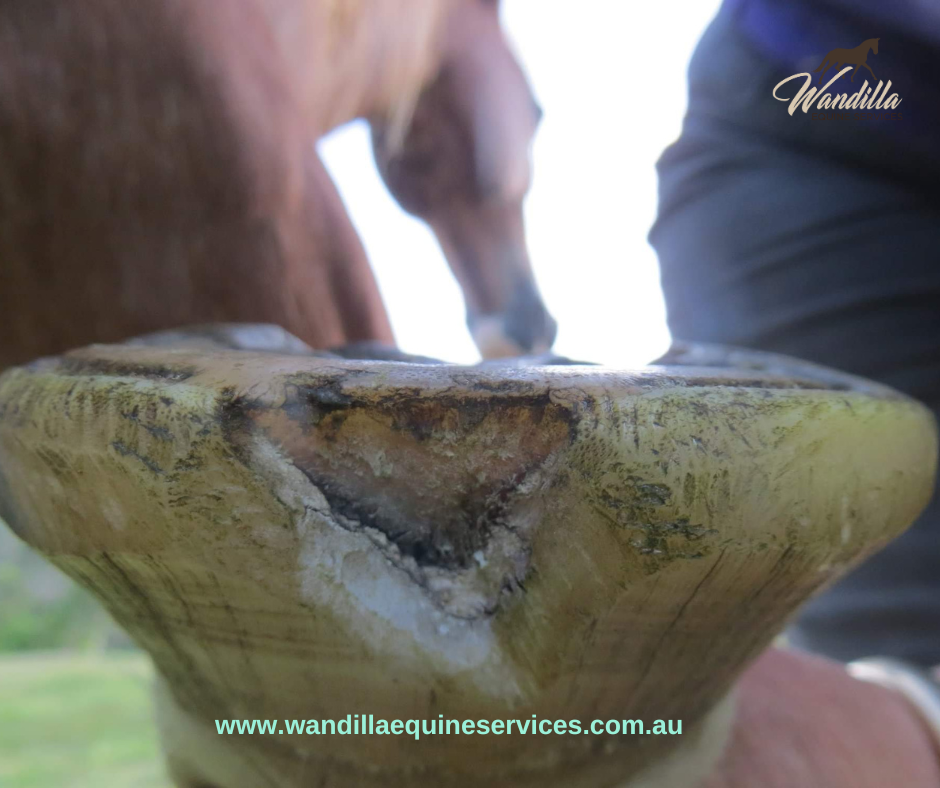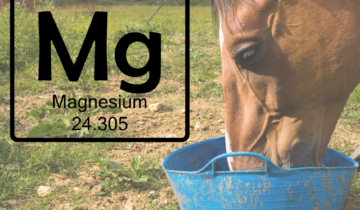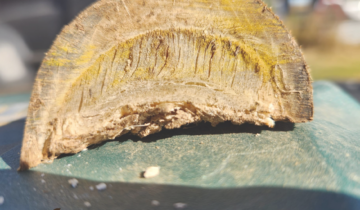Seedy toe (also known as white line disease) is the bain of every hoof professional’s existence! It’s an invasion of anaerobic pathogens invading the inner hoof wall and/or white line literally “eating” the inner hoof/laminae wall leaving a path of black crud. It’s sinister and hides behind what seems to be small hoof cracks at the distal border of the hoof.
In my experience, the more significant cases are worse in the Queensland coastal environments than in areas further west. And if this wet weather comes through, we’re likely to start seeing it raise its ugly head.
As soon as the integrity of the hoof is broken, this creates an opportunity for pathogen bugs to enter your horse’s foot and start munching happily away on the inner hoof wall or white line. When I find seedy toe starting in the hoof, it looks like a fine black line in the inner hoof wall/white line and can be superficial. It generally can be removed with one slice of the rasp or knife. But more insidious cases will find the inner hoof wall and white line have started to manoeuvre up the hoof wall – this can sometimes require the intervention of your vet because seedy toe can be so invasive.
Did you know, that stretched laminae can be an inlet for seedy toe? Hence the need for tight connective laminae via regular trimming. Yes, I know it’s challenging to keep on top of but it’s important. A hoof care professional is only seeing a horse every 4-5 weeks with a time allocation of 30 minutes (in my case) so it’s really important for the owner to treat the seedy toe in between trimming cycles! So, here comes the big question – what is the appropriate duration between trims? This really depends on what the environment is that your horse lives in and what you do with your horse. Iif growth = wear, then the foot may only require maintenance trimming every 10 weeks, but if you live in South East Queensland and your horse lives in a nice soft paddock that gets ridden once a week, then s/he might require fortnightly to four weekly trims – at the end of the day it depends! This is where you as the horse owner become the detective by learning what to recognise in the hoof for pathology and/or excess hoof growth. By empowering yourself with knowledge you can communicate with your vet or hoof care professional and get onto the problem before it becomes a major issue – big issues like hoof resection and worst-case scenario radiographs and regular trimming/farrier work are costly and intensive to manage.
I’ve seen enough seedy toe now to know that it’s easily preventable with regular inspection and cleaning of the hoof, an appropriate trimming cycle for your horse’s needs and of course a nutritionally balanced diet. I also know that seedy toe can be devastating if left to it’s own devices!
What can be done to prevent and/or manage seedy toe?
1. Maintain a regular trimming cycle of no more than 4-5 weeks. This will prevent the hoof from cracking. Sometimes trimming intervals might need to be closer when pathology exists.
2. Learn to recognise the visual signs of seedy toe (plenty of pics on the internet.)
3. Pick your farrier/trimmer’s brain – ask lots of questions and get them to show you what seedy toe looks like and what it can do to the hoof. I’m pretty sure that they will be obliging especially when they are resecting.
4. Seedy toe will not grow out with just a bevel in my experience…it needs to be resected.
5. Soaking without resection may help, I say maybe as I’ve had clients soak every day for a month and it’s not prevented the seedy toe. Post-resection soaking is fine and may help.
6. Once your hoof care professional has resected the seedy toe, maintain a strict cleaning protocol of diluted hydrogen peroxide, cleaning daily with a toothbrush (or similar) and then every other day. I know this is an inconvenience, but remember the old saying no hoof no horse. Your horse is relying on you to be their advocate and look after their feet.
7. Scrubbing feet with a wire brush and warm salty water can give you a clearer picture of what’s lying under all that dirt and mud, I would do that weekly….this is particularly important for coastal horses.
8. If possible, provide an area that is dry and free from damp wet grass. Yes I know…this is difficult but horse’s feet need to dry out. Another option is to wrap the feet in nappies with some zinc oxide powder and put them in hoof boots overnight. Any break from constant moisture is a bonus.
9. Feed a supplement with optimum copper and zinc with a 1:3 ratio and quality protein. Reach out if you aren’t sure which Wandilla Mineral Mix is right for your steed.
10. Again watch for those minuscule small cracks on the external hoof wall that can be a disaster underneath. Contact your farrier/trimmer if you see this developing so they can get onto it before it gets out of hand.
11. If seedy toe becomes so encapsulated that a significant portion of the hoof wall needs to be resected, then shoes whether poly or steel may need to be applied. We all remember the video going viral on Facebook where the farrier took away most of the external hoof wall…don’t let that happen to your horse.
As Dr Kellon says “The horse’s feet are a sensitive indicator of nutrition overall.”



 No products in the cart.
No products in the cart.